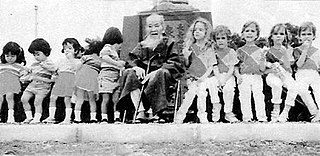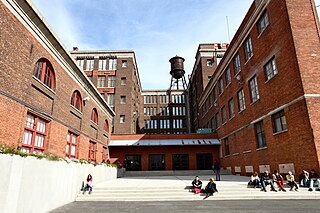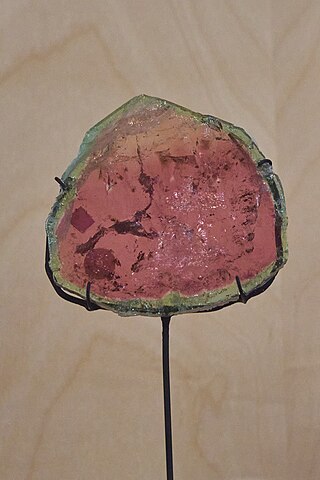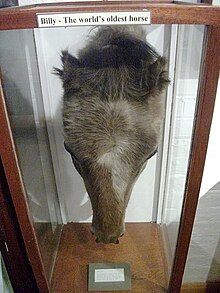
The Four Horsemen of the Apocalypse are figures in the Book of Revelation in the New Testament of the Bible, a piece of apocalypse literature written by John of Patmos. They are not specifically identified there but subsequent commentary often identifies them as personifications of Death (Thanatos), Famine (Limos), War (Ares), and Conquest or Glory (Zelus).

The Alabama Hills are a range of hills and rock formations near the eastern slope of the Sierra Nevada in the Owens Valley, west of Lone Pine in Inyo County, California.

Puabi, also called Shubad or Shudi-Ad due to a misinterpretation by Sir Charles Leonard Woolley, was an important woman in the Sumerian city of Ur, during the First Dynasty of Ur. Commonly labeled as a "queen", her status is somewhat in dispute, although several cylinder seals in her tomb, labeled grave PG 800 at the Royal Cemetery at Ur, identify her by the title "nin" or "eresh", a Sumerian word denoting a queen or a priestess. Puabi's seal does not place her in relation to any king or husband, possibly indicating that she ruled in her own right. It has been suggested that she was the second wife of king Meskalamdug. The fact that Puabi, herself a Semitic Akkadian, was an important figure among Sumerians, indicates a high degree of cultural exchange and influence among the ancient Sumerians and their Semitic neighbors. Although little is known about Puabi's life, the discovery of Puabi's tomb and its death pit reveals important information as well as raises questions about Mesopotamian society and culture.

Shigechiyo Izumi was a Japanese man who was titled the oldest living person after the death of Niwa Kawamoto on 16 November 1976, also from Japan. Izumi's claimed birth date of 29 June 1865 was accepted by Guinness World Records, which recognized him as the oldest verified man ever, but this was eventually withdrawn in 2010; in the 2012 edition of the Guinness World Records book, Christian Mortensen was named the "oldest verified man ever" and Izumi was not mentioned.

A chained library is a library where the books are attached to their bookcase by a chain, which is sufficiently long enough to allow the books to be taken from their shelves and read, but not removed from the library itself. The practice was usual for reference libraries from the Middle Ages to around the 18th century. This would prevent theft of the library's materials. Since the chaining process was also expensive, it was not used on all books, only the more valuable books such as reference works or large books in a collection were chained. Librarians in the Middle Ages often invoked curses as well to keep books from being stolen. Once such curse written into the books was,

Cabazon Dinosaurs, formerly Claude Bell's Dinosaurs, is a roadside attraction in Cabazon, California, featuring two enormous, steel-and-concrete dinosaurs named Dinny the Dinosaur and Mr. Rex. Located just west of Palm Springs, the 150-foot-long (46 m) Brontosaurus and the 65-foot-tall (20 m) Tyrannosaurus rex are visible from the freeway to travelers passing by on Southern California's Interstate 10. The roadside dinosaurs are best known for their appearance in the film Pee-wee's Big Adventure (1985).

Creme Puff was a mixed tabby domestic cat, owned by Jake Perry of Austin, Texas, US. She was the oldest cat ever recorded, according to the 2010 edition of Guinness World Records, when she died aged 38 years and 3 days.
Ann Street is a 3-block-long street located in the Financial District in Lower Manhattan. It runs roughly east to west from Broadway to Gold Street.
The Museum at Eldridge Street is a museum located within the Eldridge Street Synagogue that tells the story of its congregation and contemporary Jewish culture and practice. While historically part of the Lower East Side of Manhattan, Chinatown has expanded east and the museum is considered to be part of both neighborhoods. The museum, which was designed by Walter Sedovic and Jill H. Gotthelf, opened in December 2007 following the synagogue's twenty-year renovation, during which time it was known as the Eldridge Street Project. The capstone of the renovation was the installation of Kiki Smith and Deborah Gans' stained glass window to replace a plain one that congregation had installed to protect the sanctuary when funds were limited. The museum later played host to an exhibit dedicated to Smith's work.

The Royal Eise Eisinga Planetarium is an 18th-century orrery in Franeker, Friesland, Netherlands. It is currently a museum and open to the public. The orrery has been on the top 100 Dutch heritage sites list since 1990. In September 2023, it received the status of UNESCO World Heritage Site. It is the oldest working orrery in the world.

View of Delft is an oil painting by Johannes Vermeer, painted c. 1659–1661. The painting of the Dutch artist's hometown is among his best known. It is one of three known paintings of Delft by Vermeer, along with The Little Street and the lost painting House Standing in Delft, and his only cityscape. According to art historian Emma Barker, cityscapes across water, which were popular in the Netherlands at the time, celebrated the city and its trade. Vermeer's View of Delft has been held in the Dutch Royal Cabinet of Paintings at the Mauritshuis in The Hague since its establishment in 1822.

Mana Contemporary is a cultural center in Jersey City, New Jersey, United States with affiliated centers in Chicago and Miami.
Humans are the longest-lived hominid species, with a human named Jeanne Calment being the longest-lived hominid ever, at 122 years. Other members of the family Hominidae are shorter-lived. This article lists the oldest known individuals of each hominidae species.

The land comprising New York City holds approximately 5.2 million trees and 168 different tree species, as of 2020. The New York City government, alongside an assortment of environmental organizations, actively work to plant and maintain the trees. As of 2020, New York City held 44,509 acres of urban tree canopy with 24% of its land covered in trees.

Schermerhorn Hall is an academic building on the Morningside Heights campus of Columbia University located at 1190 Amsterdam Avenue, New York City, United States. Schermerhorn was built in 1897 with a $300,000 gift from alumnus and trustee William Colford Schermerhorn. It was designed by McKim, Mead & White, and was originally intended to house the "natural sciences". During the early 20th century, it was used for studying botany, geology, physics, mechanics, and astronomy. The inscription above the doorway reads, "For the advancement of natural science. Speak to the earth and it shall teach thee." Today, Schermerhorn Hall houses the Departments of Art History and Archeology, Earth and Environmental Science, and Psychology.

The Maine Mineral and Gem Museum is a geology museum located in Bethel, Maine. It displays a collection of rocks, minerals, and meteorites.













